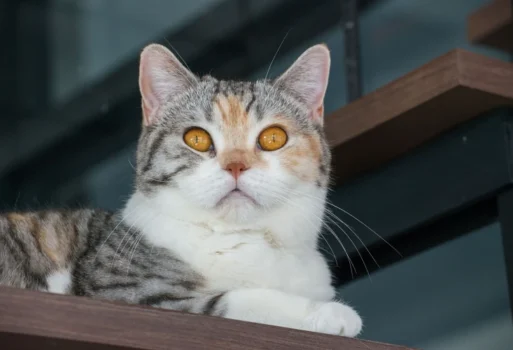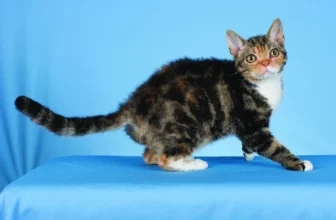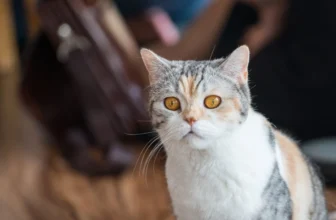As cat-lovers, we’re always fascinated with the traits that make each breed special. One such breed is the American Wirehair, a unique feline with an intriguing history and genetics. So, what makes the American Wirehair so special? In this detailed article, we’ll explore everything from the role of genetics in their development, their health, personality, and how to properly care for them. Let’s dive in and discover the world of American Wirehair cats.
The History of American Wirehair Cats
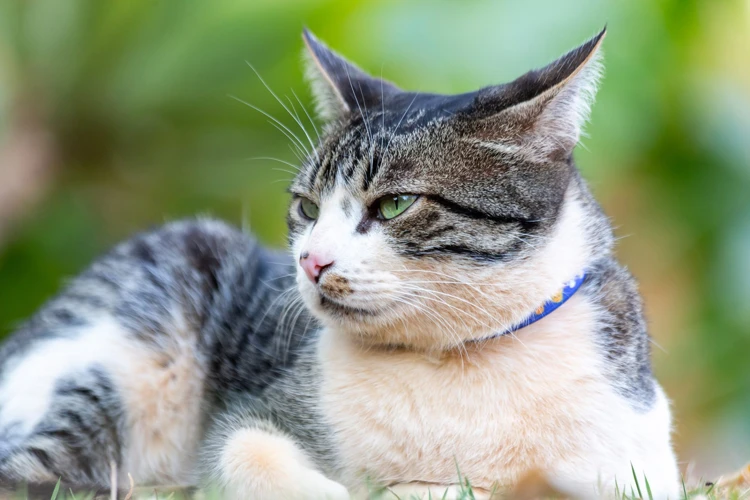
The evolution of cat breeds has been a fascinating journey, and the American Wirehair is no exception. This beloved feline has a rich history, from its origins in upstate New York to its recognition as a distinct breed. Studying the American Wirehair’s past can help us understand how certain physical traits and personalities have been developed over time. Let’s explore the history of this unique cat and discover what makes it so special. To learn about the development of the breed standard, check out the impact of breed standards on the American Wirehair.
The First American Wirehair Cat
The American Wirehair is a unique breed that originated in upstate New York in 1966, with the birth of the first American Wirehair cat, a kitten named Adam. Adam was born to a litter of six kittens in a barn located in Verona, New York. His distinctive wiry coat immediately caught the attention of cat enthusiasts Joan O’Shea and her husband, who were visiting Adam’s owners.
Upon realizing that Adam was a new and unusual breed, O’Shea purchased him and began breeding him to other cats with similar genetics. Through careful breeding and genetic testing, O’Shea was able to establish the American Wirehair breed with an official breed standard in 1967.
Today, American Wirehair cats are known for their unique coat texture and robust, playful dispositions. They have been praised by breeders and owners alike for their exceptional personality traits, energy, and affectionate nature.
The creation of the American Wirehair breed was not without its critics, however. Some breed enthusiasts were concerned about the impact that the breed might have on the American Shorthair, as it was initially thought that the mutation responsible for the wirehair trait was carried primarily by American Shorthair cats.
Despite these concerns, the American Wirehair breed gained popularity rapidly and has since been recognized by multiple cat breed associations around the world. The first American Wirehair cat show was held in 1967 in Helsinki, Finland, and the breed has continued to grow in popularity ever since.
The first American Wirehair cat was a true pioneer in the world of cat breeding, paving the way for many other iconic breeds. Today, the breed remains a favorite among cat enthusiasts around the world, and has even undergone significant grooming evolution over the years.
Developing the Breed Standard
Developing the breed standard for American Wirehair cats was a meticulous process that involved several breeders and feline associations. The goal was to establish a standardized set of physical characteristics to delineate the breed. The breed standard describes the ideal characteristics of American Wirehair cats, including their size, build, coat color, and texture.
The American Wirehair Cat Association played a significant role in developing and setting the breed standard. They appointed a breed standard committee consisting of experienced breeders, veterinarians, and cat fanciers who worked diligently to ensure its accuracy.
The committee set guidelines for the size and weight of American Wirehair cats, and detailed the standard for their coats. The coat texture was a critical factor for the breed, as it was necessary to differentiate them from the American Shorthair breed. The committee described the coat as having a springy and resilient texture, with dense, coarse, and wired strands that could be wavy or curly.
Once the breed standard was written, breeders had to follow it precisely when presenting their cats for breed shows. The first American Wirehair cat show was held in 1964, where the cats were assessed according to the new breed standard. Breeders who adhered to the American Wirehair cat’s standard were rewarded, and cats that didn’t meet the specifications were disqualified.
Over time, the breed standard has been refined and updated as necessary, taking into consideration advancements in veterinary science and new mutations that have been discovered. Breeders need to stay current with the breed standard to ensure healthy litters, and it is essential to maintain the integrity of the breed.
The evolution of the breed standard of American Wirehair cats is an exciting and ongoing process. For those interested in learning more about the history of American Wirehair breeders or the impact of American Shorthair cats on the breed, historical breeders to American shorthair crosses can be enlightening. Additionally, if you want to learn more about grooming evolution, we have got you covered too!
Acknowledgement as a Distinct Breed
After the American Wirehair was first discovered, it took some time for it to be acknowledged as a distinct breed. However, with the establishment of breeding standards and the careful selection of cats with the Wirehair trait, the breed began to gain recognition.
In 1967, the Cat Fancier’s Association officially recognized the American Wirehair as a breed. The breed has since gained popularity, both in the United States and abroad. It is now recognized by many other cat fancier organizations around the world.
Since its recognition, the American Wirehair has become a popular show cat. Its unique coat and striking appearance make it a favorite among cat lovers. In fact, the breed’s first official cat show was held in 1964 at the All-Cat Club Show in Madison Square Garden. It was a huge success and helped to bring the breed to the attention of cat enthusiasts.
The American Wirehair’s growth in popularity and recognition as a distinct breed is a testament to the unique traits and characteristics that set it apart. With careful breeding and the selection of cats that meet the established standards, the American Wirehair has established itself as a significant and highly valued breed within the cat fancier community.
The acknowledgement of the American Wirehair as a distinct breed was a significant moment in the breed’s history, paving the way for its continued growth and popularity. Interested readers can learn more about the first American Wirehair Cat Show in 1964 here.
The Genetics of American Wirehair Cats
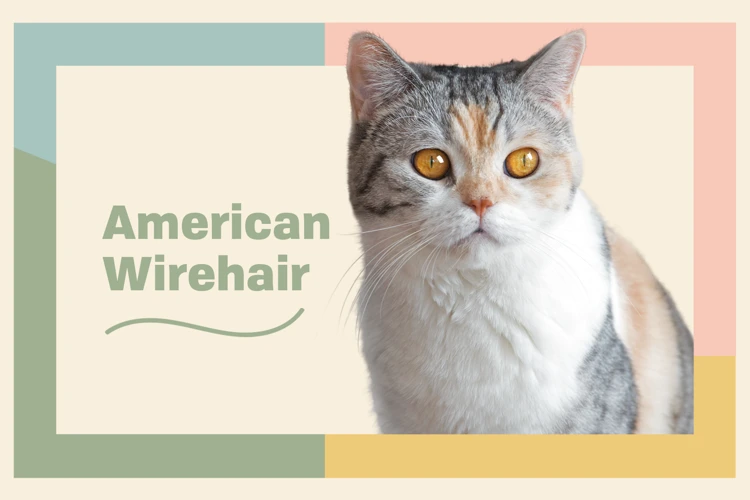
When it comes to understanding the development of the American Wirehair cat, it’s important to take a closer look at their genetics. The unique characteristics of this breed are largely influenced by their genes, and the story behind their signature wirehair coat is particularly intriguing. From the mutation responsible for the wirehair trait to the heritability of physical traits, let’s explore the fascinating topic of American Wirehair cat genetics.
The Mutation Responsible for the Wirehair Trait
The American Wirehair cat has a unique and distinctive coat that sets it apart from other breeds. This trait is the result of a genetic mutation that occurred naturally in the breed’s ancestry. The mutation responsible for the wirehair trait is known as the “spontaneous mutation,” which is a natural occurrence that happens randomly.
The spontaneous mutation occurs in the gene responsible for producing hair in cats. In American Wirehair cats, this mutation causes the hair to become coarser, denser, and crimped, giving it the unique “wirey” appearance. This mutation is dominant, meaning that if one parent carries the gene, their offspring will also have the wirehair trait.
It is important to note that not all American Wirehair cats carry this gene, and it is not necessary for a cat to have this trait to be considered an American Wirehair. Carriers of the gene but not showing the trait are referred to as “shorthair carriers.”
To better understand the mutation responsible for the wirehair trait, let’s take a look at the following table:
| Gene | Normal Hair | Wirehair Trait |
|---|---|---|
| AA | Normal haired | Normal haired carrier |
| Aa | Normal haired | Wirehaired |
| aa | Normal haired | Normal haired |
The table above illustrates the possible outcomes when breeding American Wirehair and non-wirehair cats. A capital “A” represents the dominant gene for normal hair, while a lowercase “a” represents the dominant gene for the wirehair trait.
When two normal hair cats breed, their offspring will also have normal hair, represented by the “AA” genotype. However, if one of the parents carries the recessive gene for the wirehair trait, their offspring has a 50% chance of inheriting the gene and showing the wirehair trait.
The mutation responsible for the wirehair trait in American Wirehair cats is a natural occurrence that happened randomly in the breed’s ancestry. It is a dominant gene that is passed on to offspring, resulting in a unique and distinctive coat. Not all American Wirehair cats carry this gene, but those that do are highly sought after and prized by breeders and cat enthusiasts alike.
Heritability of the Wirehair Trait
When studying the genetics of American Wirehair cats, it’s important to understand the heritability of the wirehair trait. According to studies, the wirehair trait is an autosomal dominant trait, which means that a cat only needs to inherit one copy of the mutated gene from either parent to express the trait.
To break it down, each cat has two copies of every gene, one from their mother and one from their father. In the case of the wirehair trait, the mutated gene dominant, which means that if a cat inherits one copy of the mutated gene, their hair will be wiry. This can be represented in an HTML table as follows:
| Genotype | Phenotype |
|---|---|
| AA | Wiry hair |
| Aa | Wiry hair |
| aa | Smooth hair |
AA represents a cat that inherited two copies of the mutated gene, Aa is a cat that inherited one copy of the mutated gene and one copy of the non-mutated gene, and aa is a cat that inherited two copies of the non-mutated gene.
It’s important for breeders to understand the heritability of the wirehair trait when breeding American Wirehair cats. By breeding two cats with the wirehair trait, breeders can produce offspring that have an increased likelihood of also having the trait. However, breeders should also be careful not to breed cats with other genetic traits that may lead to health issues in offspring.
Other Genetic Physical Traits of American Wirehair Cats
American Wirehair cats are known not just for their unique wiry coat, but also for some other distinct characteristics that are a result of genetics. These traits include:
- Curved Whiskers: In addition to their curly hair, American Wirehairs also have curved whiskers. This unique trait is thought to be related to the same gene that causes the curly hair.
- Paws: American Wirehair cats have thick, firm paws that are often described as “paddington bear” like. These paws are also thought to be a result of the same gene that causes their curly hair.
- Solid Muscles: The American Wirehair breed is known for having a solid build and well-developed muscles. They are often described as “brick-shaped” or “dense”. This trait is believed to be related to their hunting heritage.
- Ear tufts: Some American Wirehair cats have tufts of hair on the tips of their ears, which is a common trait in other breeds like the Maine Coon and Siberian breeds. It is thought to be related to the same gene that causes the curly hair.
- Different colored eyes: Some American Wirehair cats have two different colored eyes, a condition that is known as heterochromia. This occurs when there is a genetic mutation that affects the way melanin is distributed in the iris. Although this isn’t exclusive to the American Wirehair breed, it is still fascinating to note.
These traits all add to the unique and fascinating nature of the American Wirehair breed. Despite their distinct features, however, American Wirehairs are still just as lovable and affectionate as other breeds. It’s important to remember that genetics play a significant role in shaping not just a cat’s appearance, but also its temperament and health. As pet owners, it is our responsibility to do our research and understand what goes into breeding and caring for any pet, including this beloved and fascinating breed.
American Wirehair Cat Health
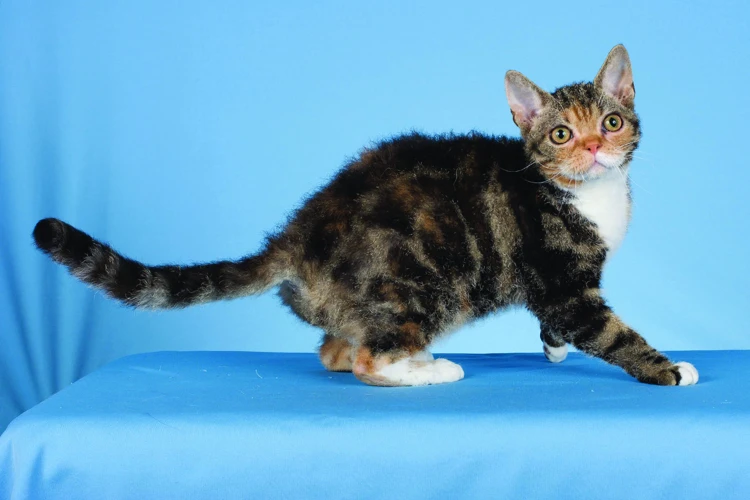
Ensuring the good health and well-being of American Wirehair cats is of utmost importance to any responsible owner. Genetics play a crucial role in determining these cats’ health issues, and as such, it is essential to have a clear understanding of this breed’s genetic makeup. In this section, we’ll dive into the common health issues that affect American Wirehair cats, examine the importance of genetic health testing, and discuss responsible breeding practices for this unique breed. So, let’s take a closer look at these important considerations to help ensure that your American Wirehair remains happy and healthy throughout their lifetime.
Common Health Issues
As with any breed, American Wirehair cats may be predisposed to certain health issues. It is important for pet owners to be aware of these potential health concerns, so they can take preventative measures or seek veterinary care if needed. Some common health issues that American Wirehair cats may experience include:
| Health Issue | Description |
|---|---|
| Polydactyly | A condition in which the cat has extra toes on one or more paws. This is a genetic trait and can be screened for in breeding programs. |
| Heart disease | American Wirehair cats may be predisposed to hypertrophic cardiomyopathy, a condition in which the heart muscle thickens and makes it difficult for the heart to pump blood effectively. |
| Obesity | American Wirehair cats may be prone to obesity if their diet is not carefully monitored and they are not given enough exercise. |
| Urinary tract infections | As with many cats, American Wirehairs may be susceptible to urinary tract infections, which can cause discomfort and in severe cases, kidney damage. |
| Dental issues | American Wirehairs may be at risk for dental issues such as periodontal disease or tooth decay. Regular dental cleanings and exams are important to maintain good oral health. |
While these health issues may be a concern, there are steps owners can take to prevent or manage them. Regular veterinary check-ups, a balanced diet, and regular exercise can help keep American Wirehair cats healthy. It is also important to note that responsible breeding practices, such as genetic screening and health testing, can help reduce the prevalence of inherited health issues in the breed. By being informed and vigilant about their cat’s health, owners can help ensure their American Wirehair lives a long, healthy life.
Understanding Genetic Health Testing for American Wirehair Cats
Genetic health testing is an essential aspect of responsible breeding for American Wirehair cats. It involves analyzing the DNA of the cat to detect potential genetic health issues that could be passed on to future generations. Testing can be done on both parents before breeding to ensure that the offspring are healthy and free from any inherited diseases.
There are various types of genetic tests available, including:
| Type of Genetic Test | Description |
|---|---|
| Responsible Breeding Test | This test identifies the presence or absence of a certain gene mutation that could lead to inherited diseases in American Wirehair cats. If both parents carry the gene, they should not be bred together. |
| Diagnostic Test | This kind of test is used to diagnose a genetic condition already present in an American Wirehair cat. It’s essential to ensure a suitable treatment plan is implemented for the individual cat. |
| Carrier Test | If an American Wirehair cat carries a gene mutation known to cause hereditary diseases, this test can identify it and determine their carrier status. Although the cat will not express the disorder, future generations could be affected. |
| Preimplantation Genetic Diagnosis (PGD) | This test is done before an embryo is implanted to identify any genetic abnormalities the embryo may carry. |
A responsible breeder will often perform a genetic health test before breeding two American Wirehair cats to ensure that future generations are healthy. Results of genetic health testing should be openly shared with potential adopters, and ethical breeders will avoid breeding cats with known health issues.
Genetic health testing is a crucial aspect of responsible breeding to prevent inherited diseases in American Wirehair cats. Regular tests provide cat owners and breeders with the information required to make informed decisions about their breeding programs and the health and welfare of their cats.
Breeding American Wirehair Cats Responsibly
Breeding American Wirehair Cats is a serious and responsible task since it involves the perpetuation of a distinctive breed. It is crucial to ensure that the cats used for breeding are healthy, have a good temperament, and conform to the breed standards. Here are the key factors to consider when breeding American Wirehair Cats responsibly:
- Choose Healthy Cats: Ensure that the breeding cats are screened for common genetic health issues, such as hip dysplasia and heart problems. Consider testing for coat color genetics, blood type, and other health markers to avoid potential health issues.
- Conform to Breed Standards: Select cats that meet the standards set by the Cat Fanciers’ Association (CFA) for American Wirehair Cats. This includes physical features, such as the wiry coat, round head, and almond-shaped eyes. Breed for traits that benefit the cat’s health and well-being.
- Avoid Inbreeding: Inbreeding can result in a higher prevalence of genetic defects and health issues. Breed with cats that are not closely related to maintain genetic diversity in the breed.
- Monitor Litters: Observe the kittens for physical abnormalities and behavior issues. Kittens should have good temperaments and be well-socialized. Tests can be performed at an early age to ensure that the kittens are healthy.
- Encourage Responsible Ownership: Provide new owners with information on the breed’s needs, temperament, and behavior. Ensure that the kittens are spayed or neutered if they are not going to be used for breeding.
By breeding American Wirehair Cats responsibly, breeders can help maintain the breed’s health, temperament, and distinctive characteristics. It is important to keep in mind that breeding cats is more than just producing kittens; it is a commitment to the breed and to improving its overall quality.
Personality and Temperament
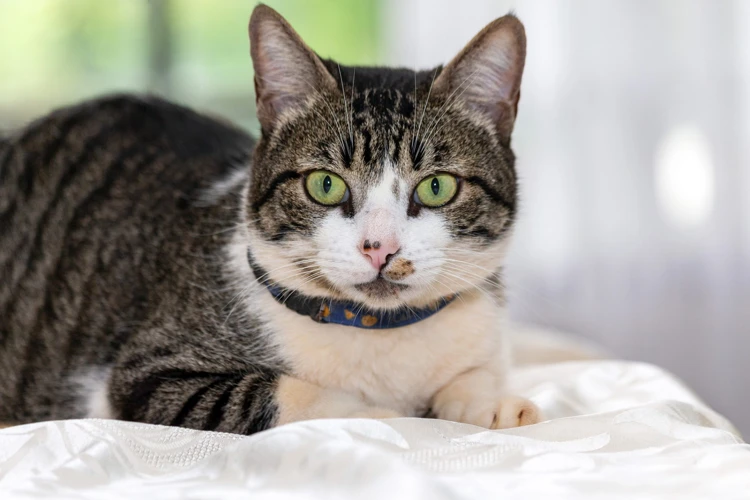
Our feline friends have different personalities and temperaments, and the American Wirehair is no exception. These unique cats have distinct traits that make them stand out from other breeds. From their interactions with humans to their relationship with other pets, the American Wirehair’s personality is shaped by a variety of factors, including genetics and environment. Let’s delve deeper into what makes these cats so special.
Association with Other Breeds
The American Wirehair cat breed is unique in many ways, especially when it comes to its genetics. However, when it comes to personality and behavior, many cat enthusiasts are curious about how the breed interacts with other cat breeds. Here are some associations you might want to know about:
- Domestic Shorthair: These two breeds have much in common, both being native to America. Because of their similar personalities, American Wirehair cats make great companions for Domestic Shorthairs.
- Persian: The American Wirehair’s wiry coat is vastly different from the plush, luxurious coat of the Persian cat. However, these two breeds can coexist peacefully as long as they are properly introduced and socialized.
- Siamese: The Siamese and American Wirehair share similar levels of energy, intelligence, and sociability. Because of these similarities, the two breeds can generally get along well together.
- Maine Coon: The Maine Coon and American Wirehair are both native to America and have a similar independent streak. As long as they are introduced carefully and given plenty of space, they can coexist easily in the same household.
It’s worth noting that every cat, regardless of breed, has its own unique personality. While these associations can offer some guidance, it’s important to consider each cat’s individual needs and temperament when introducing them to another cat, regardless of breed. With patience, proper socialization, and supervision, cats of different breeds can live harmoniously together.
Family-Friendly Traits
American Wirehair cats are known to be family-friendly pets due to their unique personality traits and disposition. These cats make great companions for families with children, as they are patient and tend to be very loving.
Temperament: American Wirehair cats are known for being calm and affectionate, making them an ideal family pet. They are generally very social and friendly, and will often seek out their owner’s attention and affection.
Playfulness: American Wirehair cats love to play and can provide endless entertainment for children. They are known to be very agile and active, making them great playmates for kids who want an energetic and lively pet.
Sociability: American Wirehair cats are very sociable and enjoy being around people. They are comfortable in social situations and are generally good with other pets, making them an excellent addition to any family.
Intelligence: American Wirehair cats are intelligent and quick learners, which makes them an excellent pet for families. They can learn tricks and commands easily, and are very trainable.
Gentleness: American Wirehair cats are gentle creatures by nature and tend to be patient with children. They are not prone to aggressive behavior and are generally very tolerant of being handled by children.
To summarize, American Wirehair cats possess many family-friendly traits, making them ideal for households with children. Their loving disposition, playfulness, sociability, intelligence, and gentleness are all qualities that make them great family pets.
Intelligence and Trainability
There is no doubt that the American Wirehair cat breed is both intelligent and highly trainable. These cats have the capacity to learn and respond to training quickly, making them an excellent choice for families or individuals who enjoy spending time teaching and interacting with their feline companions.
Below is a table that provides some key characteristics of the American Wirehair breed’s intelligence and trainability:
| Characteristic | Description |
|---|---|
| Adaptability | American Wirehair cats are known for their adaptability, which means they are highly responsive to changes in their environment. This makes them easier to train than some other breeds. |
| Problem Solving Skills | American Wirehair cats are known for their problem-solving skills, which allows them to learn quickly and react to new situations with ease. They are also highly independent, which means they will often find their way out of problems on their own. |
| Trainability | These cats are highly trainable and are able to learn a wide variety of commands and tricks. They respond well to positive reinforcement and reward-based training methods, making them an excellent choice for families with children. |
| Intelligence | American Wirehair cats are highly intelligent and have a strong desire to learn and interact with their owners. They are curious creatures and enjoy exploring their surroundings, which can make training and playtime all the more fun. |
| Attention Span | American Wirehair cats have a longer attention span than many other breeds, making them more receptive to training and able to retain information for longer periods of time. |
When it comes to training an American Wirehair cat, it is important to be patient and consistent. Positive reinforcement is key, as these cats respond well to rewards and praise. Treats, toys, and verbal affirmations are all effective tools for training an American Wirehair. It is important to provide plenty of mental and physical stimulation to keep these cats engaged and motivated. Interactive toys, puzzle feeders, and playtime with human companions are all great options for keeping an American Wirehair cat mentally and physically active.
The intelligence and trainability of the American Wirehair cat breed is one of its most attractive features. With patience, consistency, and positive reinforcement, these cats can learn to do almost anything, making them excellent companions for families and individuals alike.
Caring for an American Wirehair Cat
When it comes to caring for any pet, including an American Wirehair cat, it’s essential to provide them with proper nutrition, grooming, and a safe environment. However, each breed may have unique requirements and considerations to keep them healthy and happy. In this section, we’ll dive into the specific needs of American Wirehair cats and what you can do to ensure they thrive in your home. From dietary recommendations to environmental considerations, we’ll cover everything you need to know about caring for an American Wirehair cat. So, let’s get started!
Nutritional Needs
Proper nutrition is essential for the health and wellbeing of American Wirehair cats. Their dietary needs are similar to other domestic cats, with a focus on high-quality proteins and balanced nutrients.
Protein: American Wirehair cats require high levels of protein in their diet to support their muscular and active lifestyle. Look for cat food that lists real meat, such as chicken or fish, as the primary ingredient. Aim for at least 30% protein in their daily diet.
Fat: While fat should be limited in a cat’s diet, it’s still an essential nutrient that provides energy and important fatty acids. Look for cat food that lists healthy fats, such as salmon oil or chicken fat, rather than fillers like cornmeal or soybean oil.
Carbohydrates: Cats don’t require a lot of carbohydrates in their diet, but some are necessary for energy and digestive health. Look for a smaller amount of carbohydrates, ideally from whole food sources like sweet potatoes or peas.
Vitamins and Minerals: American Wirehair cats need a variety of vitamins and minerals in their diet to support healthy skin, fur, and organ function. Look for cat food that includes essential vitamins and minerals in balanced amounts, such as vitamin A, B12, D, and calcium.
It’s important to note that American Wirehair cats have individual nutritional needs based on their age, weight, and activity level. Always consult with a veterinarian to determine the most appropriate diet for your cat. Additionally, providing fresh water and monitoring their food intake can help prevent health complications, such as obesity and kidney disease.
Here’s an example of a daily feeding guide for an adult American Wirehair cat:
| Meal | Food Type | Portion Size | Frequency |
|---|---|---|---|
| Breakfast | Dry Kibble | 1/4 – 1/2 cup | Once daily |
| Lunch | Canned food or Raw | 2 – 4 oz. | Once daily |
| Dinner | Dry Kibble | 1/4 – 1/2 cup | Once daily |
Remember to always consult with a veterinarian before making any dietary changes to your cat’s eating habits.
Grooming Requirements
To keep your American Wirehair cat’s coat healthy and shiny, regular grooming is necessary. While these cats are low maintenance when it comes to grooming, there are still a few requirements that must be met. Below is a table outlining the specific grooming needs of American Wirehair cats:
| Grooming Requirement | Description |
|---|---|
| Brushing | Despite having a wiry coat, American Wirehair cats should be brushed weekly to remove loose fur and maintain coat health and shine. |
| Bathing | American Wirehair cats do not require frequent bathing unless they get into something particularly messy or foul-smelling. No more than once every three months is recommended. |
| Nail Care | Keeping your cat’s claws trimmed is important for their safety and for maintaining healthy paws. Nails should be trimmed every 2-3 weeks. |
| Ear Cleaning | American Wirehair cats’ ears can accumulate wax and debris, which can lead to infection. Clean their ears once a week and check for any signs of redness or irritation. |
| Dental Care | Like all cats, American Wirehairs can develop dental issues without proper care. Brushing their teeth a couple of times a week and providing dental treats or toys can help prevent dental problems. |
Keeping up with these basic grooming needs will ensure your American Wirehair cat stays healthy and happy. Be sure to provide your cat with proper nutrition and a safe environment to live in as well to ensure optimum health.
Environmental Considerations
When it comes to providing a safe and suitable environment for your American Wirehair cat, there are several factors to consider. Here are some tips to keep in mind:
- Indoor vs. Outdoor: While some cats may enjoy spending time outside, it is generally recommended to keep American Wirehair cats indoors. Their dense coats provide good protection from the elements, but they can still be sensitive to extreme temperatures. Additionally, outdoor cats are at risk of injury or illness from other animals, vehicles, and environmental hazards.
- Play Areas: Indoor American Wirehair cats benefit from having plenty of opportunities to play and explore. Providing scratching posts, climbing trees, and interactive toys can help keep them mentally and physically stimulated.
- Litter Box: Make sure to provide a litter box that is large enough for your cat to comfortably use. It should also be cleaned regularly to prevent odor buildup and keep your cat healthy.
- Food and Water: Your American Wirehair cat should have access to clean food and water at all times. Choose a high-quality cat food that meets their nutritional needs, and make sure to wash their bowls regularly.
- Environmental Enrichment: American Wirehair cats are intelligent and curious animals, so providing them with plenty of stimulation is important. Consider adding indoor plants, bird feeders, or a fish tank to your home to give your cat something to watch and explore.
- Safe Spaces: Some cats may prefer to have their own private space to retreat to when they feel stressed or overwhelmed. Providing a small, cozy bed or hiding spot can give your American Wirehair cat a sense of security.
- Chemical Exposure: Make sure to keep any potentially harmful chemicals, such as cleaning products, pesticides, and medications, out of reach of your cat. These substances can be toxic if ingested, so it is important to take the necessary precautions to keep your cat safe.
By considering these environmental factors, you can create a safe and enriching home for your American Wirehair cat. Remember, as with any pet, it is important to provide them with plenty of love, attention, and care to help them thrive.
Conclusion
After delving into the history, genetics, health, personality, and care of American Wirehair cats, it is clear that this breed is truly unique and fascinating. Their wirehair trait is a result of a spontaneous genetic mutation and is a distinguishing characteristic that sets them apart from other breeds.
Understanding the genetics of American Wirehair cats is important for responsible breeding practices and ensuring their health. Regular genetic health testing can help identify potential health issues and ensure that healthy cats are being bred.
In terms of personality and temperament, American Wirehair cats are known for their affectionate and playful nature. They are intelligent and can be trained to do tricks or even walk on a leash. Their family-friendly traits make them a great pet for households with children and other animals.
Caring for an American Wirehair cat includes providing them with proper nutrition, grooming, and creating a comfortable environment for them to thrive in. Despite their unique wirehair coat, grooming requirements are generally low maintenance and they do not require any special treatment.
Overall, American Wirehair cats are a wonderful addition to any household looking for an affectionate, playful, and unique feline companion. Their genetics, health, and care should all be taken into consideration to ensure they can live happy and healthy lives.
Frequently Asked Questions
What is the origin of the American Wirehair?
The American Wirehair originated from a spontaneous genetic mutation in a farm cat in upstate New York in the 1960s.
What makes the American Wirehair unique?
The American Wirehair is the only cat breed with a wiry, springy coat due to a dominant gene mutation.
Is the American Wirehair recognized by major cat associations?
Yes, the American Wirehair is recognized by major cat associations such as the Cat Fanciers’ Association (CFA) and The International Cat Association (TICA).
Can American Wirehair cats have health problems?
Like all cat breeds, American Wirehair cats can develop certain health issues such as hypertrophic cardiomyopathy and hip dysplasia. Genetic health testing can help identify potential issues before breeding.
What kind of temperament do American Wirehair cats have?
American Wirehair cats are typically friendly, affectionate, and playful, making them great family pets.
Are American Wirehair cats good with children?
Yes, American Wirehair cats are generally good with children and enjoy playing and interacting with them.
Do American Wirehair cats require special grooming?
American Wirehair cats require minimal grooming due to their wiry coat, which doesn’t mat easily. Brushing once or twice a week and occasional bathing is typically sufficient.
What kind of food is best for American Wirehair cats?
A high-quality, protein-rich diet is best for American Wirehair cats to maintain their health and support their active lifestyle. Consult with a veterinarian for specific recommendations.
Can American Wirehair cats be trained?
Yes, American Wirehair cats are intelligent and trainable with positive reinforcement techniques.
How long do American Wirehair cats typically live?
American Wirehair cats have a typical lifespan of 13-14 years, although some have been known to live into their late teens or early twenties with proper care.

